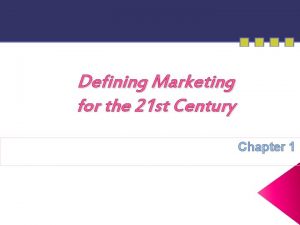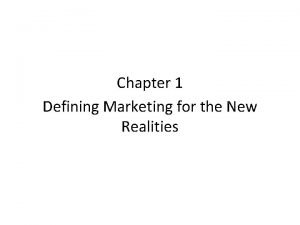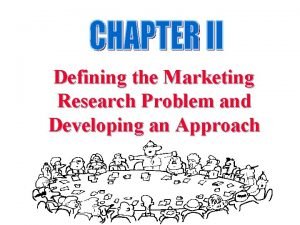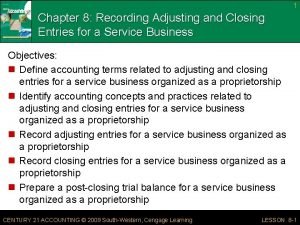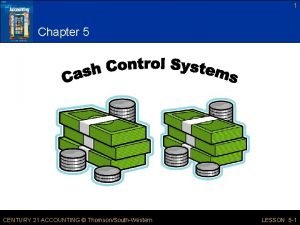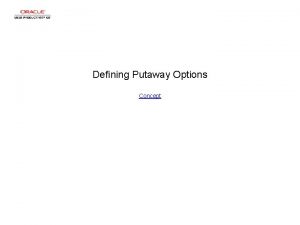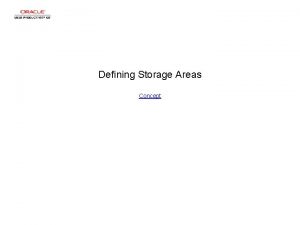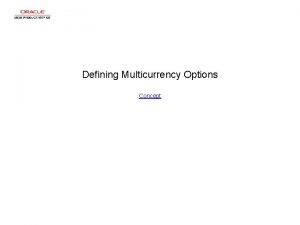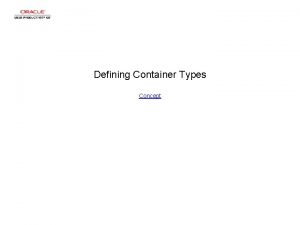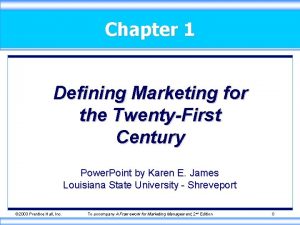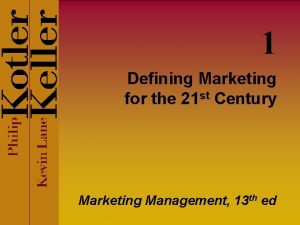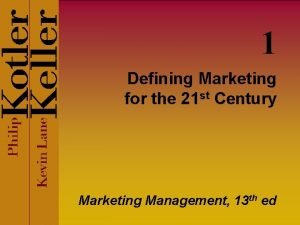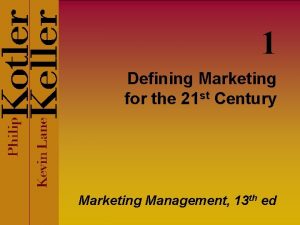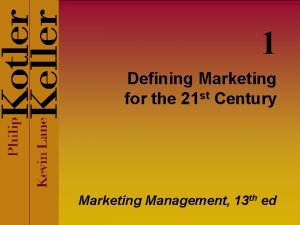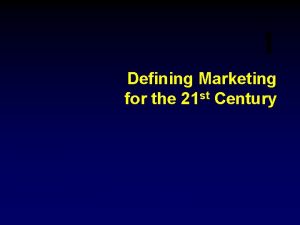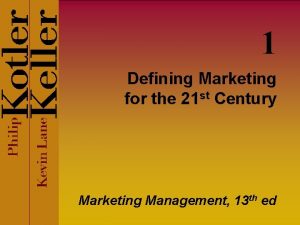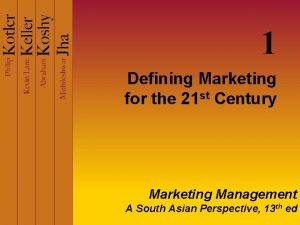Defining Marketing for the 21 st Century Chapter




















































































- Slides: 84

Defining Marketing for the 21 st Century Chapter 1

MARKETING MANAGEMENT In this chapter we will address the following questions: q What is the new economy like? q What are the tasks of marketing? q What are the major concepts and tools of marketing? q What orientations do companies exhibit in the marketplace? q How are companies responding to the new challenges?

Objectives Be able to define marketing and discuss its core concepts. � Be able to define marketing management and compare the five marketing management orientations. � Understand customer relationship management and strategies. � Realize the major challenges facing marketers in the new “connected” millennium. � 1 -3

1. Introduction a. Today’s successful companies at all levels have one thing in common. � All successful companies are: � a). Strongly customer focused. b). Heavily committed to marketing. � To be successful an organization motivates everyone in the organization to produce superior value for their customers, leading to high levels of customer satisfaction. 1 -4

What is Marketing? � Marketing is managing profitable customer relationships › Attracting new customers › Retaining and growing current customers � “Marketing” is NOT synonymous with “sales” or “advertising” � Creating customer value and satisfaction are at the very heart of modern marketing thinking and practice 1 -5

2. What is Marketing? � b. A very simple definition of marketing is managing profitable customer relationships. � a. Creating customer value and satisfaction are at the very heart of modern marketing thinking and practice 1 -6

Marketing Defined d. Many people think of marketing only as selling and advertising. � 1). Marketing is no longer “telling and selling. ” � 2). Today, marketing’s new sense is concerned with satisfying customer needs. � 1 -7

What is Marketing? � Kotler’s social definition: “Marketing is a social and managerial process by which individuals and groups obtain what they need and want through creating and exchanging products and value with others. ” 1 -8

Needs, Wants, and Demands � Human needs are the most basic concept underlying marketing. � human need is a state of felt deprivation 1 -9

1). Humans have many complex needs. a). Basic, physical needs for food, clothing, warmth, and safety. � b). Social needs for belonging and affection. � c). Individual needs for knowledge and self-expression. � These needs are part of the basic human makeup � 1 - 10

�g. Another concept in marketing is human wants. A human want is the form that a human need takes as shaped by culture and individual personality. � h. Demands are human wants that are backed by buying power. 1 - 11

Selling is only the tip of the iceberg “There will always be need for some selling. But the aim of marketing is to make selling superfluous The aim of marketing is to know and understand the customer so well that the product or service fits him and sells itself. Ideally, marketing should result in a customer who is ready to buy. All that should be needed is to make the product or service available. ” Peter Drucker 1 -12

What is Exchanged in Marketing? Goods Services Events & Experiences Persons Places & Properties Organizations Information Ideas 1 -13

Marketing Offers—Products, Services, and Experiences � Companies address needs by putting forth a value proposition, a set of benefits that they promise to consumers to satisfy their needs. j. 1 - 14

The value proposition is fulfilled through a marketing offer—some combination of products, services, information, or experiences offered to a market to satisfy a need or want. 1 - 15

Notice � Be careful of paying attention to the product and not the benefit being satisfied. � “Marketing myopia” is caused by shortsightedness or losing sight of underlying customer needs by only focusing on existing wants � Smart marketers create brand meaning and brand experiences for consumers. 1 - 16

Value and Satisfaction � Customer value is the difference between the values that the customer gains from owning and using a product and the costs of obtaining the product. Customers form expectations about the value of various marketing offers and buy accordingly. � Customer satisfaction depends on a product’s perceived performance in delivering value relative to a buyer’s expectations. Customer satisfaction is a key influence on future buying behavior 1 - 17

Value and Satisfaction Customer satisfaction depends on a product’s perceived performance in delivering value relative to a buyer’s expectations. Customer satisfaction is a key influence on future buying behavior 1 - 18

Markets � The concepts of exchange and relationships lead to the concept of a market. Market is the set of actual and potential buyers of a product. � Originally a “market” was a place where buyers and sellers gathered to exchange goods (such as a village square). � Economists use the term to designate a collection of buyers and sellers who transact in a particular product class (as in the grain or housing market). 1 - 19

Marketers � Marketers see buyers as constituting a market and sellers constituting an industry. �Marketers are keenly interested in markets 1 - 20

A Simple Marketing System 1 -21

Structure of Flows in a Modern Exchange Economy 1 -22

4 Types of Markets 1. 2. 3. 4. Consumer Market: (consumption) Business Markets: (saving/resell) Global Markets: (different offering mix) Nonprofit and Governmental Market: (bids) 1 -23

Marketing Concepts and Tools q Market: a collection of buyers and sellers q Marketplace: a physical market (store) q Marketspace: a digital market (Internet: e. g. , www. secondlife. com) q Metamarket: markets involving closely-related products and services (e. g. , www. edmunds. com) q Marketer and Prospect: A marketer is someone seeking a response from another party, called the prospect. 1 -24

Marketing Management �Marketing management is “the art and science of choosing target markets and building profitable relationships with them. ” › Creating, delivering and communicating superior customer value is key. 1 - 25

Marketing Management �Customer Management: › Marketers select customers that can be served well and profitably. �Demand Management: › Marketers must deal with different demand states ranging from no demand to too much demand. 1 - 26

Customer and Demand Management � Marketing management is concerned not only with finding and increasing demand, but also with changing or even reducing it. � 1). Demarketing’s aim is to reduce demand temporarily or permanently (move traffic away from a popular tourist attraction during peak demand times). � 2). In reality, marketing management is customer management and demand management 1 - 27

Marketing Management Orientations Selling Production concept Marketing Product concept • Societal marketing concept 1 - 28

Marketing Management Orientations �There are five alternative concepts under which organizations conduct their marketing activities: the production, product, selling, marketing, and societal marketing concepts. 1 - 29

The Production Concept The production concept holds that consumers will favor products that are available and highly affordable and that management should, therefore, focus on improving production and distribution efficiency. This is one of the oldest philosophies that guides sellers � The production concept is useful when: � 1). Demand for a product exceeds the supply. � 2). The product’s cost is too high and improved productivity is needed to bring it down. � 1 - 30

�The risk with this concept is in focusing too narrowly on company operations. Do not ignore the desires of the market. This concept can lead to “marketing myopia. ” 1 - 31

Company Orientations to the Marketplace (Marketing Management Philosophies) 1. Production concept: assumes consumers favor those products that are widely available and affordable. (Focus: wide distribution; high volume). 2. Product concept: assumes consumers will favor those products that offer the most quality, performance, and features. (Focus: Superior product) 1 -32

Company Orientations to the Marketplace, cont. 3. Selling concept: assumes that consumers will either buy or not enough of the organizations’ products unless the organization makes a substantial effort to stimulate the customer’s interest in the product. (Focus: needs of the seller) 1 -33

The purpose of marketing is to sell more stuff to more people more often for more money in order to make more profit Coca-Cola’s former Vice president 1 -34

Company Orientations to the Marketplace, cont. 4. Marketing concept: holds that the key to achieving organizational goals consists in determining the needs and wants of target markets and delivering the desired satisfactions more effectively and efficiently than competitors. (Focus: different needs of buyers) 1 -35

The Product Concept � e. The product concept states that consumers will favor products that offer the most quality, performance, and features, and that the organization should, therefore devote its energy to making continuous product improvements. 1 - 36

� 1). Some manufacturers mistakenly believe that if they “build a better mousetrap, ”consumers will beat a path to their door just for their product. � 2). The product concept can also lead to “marketing myopia, ” the failure to see the challenges being presented by other products. 1 - 37

The Selling Concept �f. Many organizations follow the selling concept. The selling concept is the idea that consumers will not buy enough of the organization’s products unless the organization undertakes a large-scale selling and promotion effort. 1 - 38

� 1). This concept is typically practiced with unsought goods (those that buyers do not normally think of buying). � 2). To be successful with this concept, the organization must be good at tracking down the interested buyer and selling them on the product benefits. 1 - 39

3). Industries that use this concept usually have overcapacity. Their aim is to sell what they make rather than make what will sell in the market � 4). There are not only high risks with this approach but low satisfaction by customers. � 1 - 40

The Marketing Concept � The marketing concept holds that achieving organizational goals depends on determining the needs and wants of target markets and delivering the desired satisfactions more effectively and efficiently than competitors do. � Under the marketing concept, customer focus and value are paths to sales and profits 1 - 41

The Marketing Concept h. The marketing and selling concepts are often confused. The primary differences are: � 1). The selling concept takes an “insideout” perspective (focuses on existing products and uses heavy promotion and selling efforts). � 2). The marketing concept takes an “outside-in” perspective (focuses on customer needs, values, and satisfactions). � 1 - 42

The Marketing Concept i. Many companies claim to adopt the marketing concept but really do not unless they commit to market-focused and customerdriven philosophies. � 1). Customer-driven companies research current customers to learn about their desires, gather new product and service ideas, and test proposed product improvements � 1 - 43

The Marketing Concept 2). Such customer-driven marketing usually works well when there exists a clear need and when customers know what they want. 3). When customers do not know what they want, marketers can try customer- driving marketing—understanding customer needs even better than customers themselves do, and creating products and services that will meet existing and latent needs now and in the future. 1 - 44

The Societal Marketing Concept � The societal marketing concept holds that the organization should determine the needs, wants, and interests of target markets. It should then deliver the desired satisfactions more effectively and efficiently than competitors in a way that maintains or improves the consumer’s and the society’s well-being. 145

The societal concept � 1). The societal marketing concept is the newest of the marketing philosophies. 2). It questions whether the pure marketing concept is adequate given the wide variety of societal problems and ills. � 3). According to the societal marketing concept, the pure marketing concept overlooks possible conflicts between short-run consumer wants and long- run consumer welfare. � 146

The societal concept calls upon marketers to balance three considerations in setting their marketing policies: a). Company profits. b). Customer wants. c). Society’s interests. 147

CRM � CRM – Customer relationship management “is the overall process of building and maintaining profitable customer relationships by delivering superior customer value and satisfaction. ” � It costs 5 to 10 times MORE to attract a new customer than it does to keep a current customer satisfied. � Marketers must be concerned with the lifetime value of the customer 148

CRM Customer value/satisfaction › Perceptions are key › Meeting/exceeding expectations creates satisfaction Loyalty and retention › Benefits of loyalty › Loyalty increases as satisfaction levels increase › Delighting consumers should be the goal Growing share of customer › Cross-selling 1 Key Concepts Attracting, retaining and growing customers Building customer relationships and customer equity 49

CRM Key Concepts • Attracting, retaining and growing customers • Building customer relationships and customer equity Customer equity › The total combined customer lifetime values of all customers. › Measures a firm’s performance, but in a manner that looks to the future. 150

CRM Key Concepts • Attracting, retaining and growing customers • Building customer relationships and customer equity Customer relationship levels and tools › Target market typically dictates type of relationship Basic relationships Full relationships › Customer loyalty and retention programs Adding financial benefits Adding social benefits Adding structural ties 151

Old Economy VS New Economy The old economy is based on the Industrial Revolution and on managing manufacturing industries WHILE … The new economy is based on the Digital Revolution and the management of information.

Marketing Concepts and Tools q Needs: the basic human requirements q Wants: specific objects that might satisfy the need q Demand: wants for specific products backed by an ability to pay. Examples: An American needs food but wants a hamburger, French fries and soft drink. Many people want a Mercedes, only a few are able and willing to buy one. 1 -53

Marketing Debate Does Marketers Create or Satisfy Needs? 1 -54

Marketing Concepts and Tools q Product: a value proposition q Offering: intangible value proposition (a combination of products, services, information and experiences (Volvo) q Brand: is an offering from a know source Examples: Mc. Donald Lexus 1 -55

Only the best is good enough for Lexus customers 1 -56

Marketing Concepts and Tools Value is a ratio between what customer gets and what he gives Value = Benefits/Costs How to increase value? q Raise benefits q Reduce costs q Raise benefits and reduce costs q Raise benefits by more than the raise of costs q Lower benefits by less than the reduction of costs 1 -57

Marketing Concepts and Tools q Exchange: a process of obtaining a product/service from someone by offering something For exchange to occur, there must be: �Two parties �Each with something of value to the other �Capable of communication and delivery �Free to accept/reject the offer �Agreement to terms Example: Caterpillar 1 -58

Marketing Concepts and Tools q Transaction: a trade of values between two or more parties. Does Transaction differs from Transfer 1 -59

Marketing Concepts and Tools q Relationship: building mutually satisfying longterm relations with key parties (customers, suppliers, distributor) in order to earn and retain their business. q Network: building mutually profitable business relationships between the company and its supporting stakeholders. 1 -60

Marketing Concepts and Tools q Marketing channels: a way/mean to reach target market. Three kinds of marketing channels: v. Communication channels v. Distribution channels v. Service channels 1 -61

Marketing Concepts and Tools q Supply Chain: longer channel stretching from raw materials to components to final products that are carried to final buyers. q Competition: all actual and potential rival offerings and substitutes that a buyer might consider. 1 -62

Marketing Concepts and Tools Four (4) levels of competition: 1. 2. 3. 4. Brand competition: A company sees its competitors as other companies offering similar products and services to the same customers at similar prices. Industry competition: A company sees its competitors as all companies making the same product or class of products. Form competition: A company sees its competitors as all companies manufacturing products that supply the same services. Generic competition: A company sees its competitors as all companies that compete for the same consumer dollars. (Example: Volkswagen) 1 -63

Marketing Concepts and Tools q Marketing Environment: actors that impact the company’s offerings (task & broad environment). q Marketing Program: a numerous decisions on the mix of marketing tools to use. q Marketing Mix: a set of marketing tools the firm uses to pursue its marketing objectives in the target market. 1 -64

The Four Ps 1 -65

The Four Ps The Four Cs Marketing Mix Place Product Customer Solution Price Conven. Promotion ience Communication 1 -66

Marketing-Mix Strategy 1 -67

Marketing Management � Marketing Management (Kotler): is the analysis, planning, implementation, and control of marketing programs designed to create, build, and maintain mutually beneficial exchanges and relationships with target markets for the purpose of achieving organizational objectives. 1 -68

Marketing and Selling Concepts Contrasted Starting Point Factory Focus Products Means Selling and Promoting Example Ends e. g. , Profits through Volume (a) The Selling Concept Market Customer Needs Integrated Marketing e. g. , Profits through Satisfaction (b) The Marketing Concept 1 -69

Theodore Levitt’s “Marketing Myopia, ” cont. ›What is the difference between marketing and selling? ›“The difference between marketing and selling is more than semantic. Selling focuses on the needs of the seller, marketing on the needs of the buyer. Selling is preoccupied with the seller’s need to convert the product into cash; marketing with the idea of satisfying the need of the customer …. ” 1 -70

Marketing Concept Four Pillar 1. Target Market: tailored marketing programs 2. Customer Needs: § § § Giving customer what they need is not enough; companies must help customers learn what they want. Stated, Real, Unstated, Delight & Secret Needs. (Inexpensive car example) Responsive, Anticipated & Creative Marketer. Market-driving firm VS Market-driven firm. Make and sell VS Sense and respond Philosophy. Why it’s important to satisfy target customers? (Customer retention) 1 -71

Marketing Concept Four Pillar 3. Integrated Marketing: all company’s departments work together to serve the customer’s interests. a. External marketing: directed at people outside the company. b. Internal marketing: the task of hiring, training, and motivating able employees who want to serve customers well. Which one is more important? 4. Profitability 1 -72

Traditional Organization Chart Top Management Middle Management Front-line people Customers 1 -73

Modern Customer-Oriented Organization Chart Customers Front-line people Middle management m to us C s er m to us er s C Top management 1 -74

What makes companies adopt marketing concept? 1. 2. 3. 4. 5. Sales decline Slow growth Changing buying patterns Increasing competition Increasing marketing expenditures 1 -75

Company Orientations to the Marketplace, cont. 5. The customer concept: � � Customer is the lifeblood of any company Customer is the King 1 -76

Company Orientations to the Marketplace, cont. 6. The societal marketing concept: to determine the needs, wants, and interests of target markets and to deliver the desired satisfaction more effectively and efficiently than competitors in a way that preserves or enhances the consumer’s and the society’s well-being. 1 -77

Societal Marketing Concept 1 -78

Marketing Challenges � Technological advances, rapid globalization, and continuing social and economic shifts are causing marketplace changes. � Major marketing developments can be grouped under theme of Connecting. 179

Marketing Challenges Connecting Via technology With customers With marketing partners With the world Advances in computers, telecommunications, video-conferencing, etc. are major forces. › Databases allow for customization of products, messages and analysis of needs. The Internet › Facilitates anytime, anywhere connections › Facilitates CRM › Creates marketspaces 180

Marketing Challenges Connecting Via technology With customers With marketing partners With the world Selective relationship management is key. › Customer profitability analysis separates winners from losers. Growing “share of customer” › Cross-selling and upselling are helpful. Direct sales to buyers are growing. 181

Marketing Challenges Connecting Via technology With customers With marketing partners With the world Partner relationship management involves: › Connecting inside the company › Connecting with outside partners Supply chain management Strategic alliances 182

Marketing Challenges Connecting Via technology With customers With marketing partners With the world Globalization › Competition › New opportunities Greater concern for environmental and social responsibility Increased marketing by nonprofit and public-sector entities › Social marketing campaigns 183

How are companies responding to the new challenges? 1. 2. 3. 4. 5. 6. 7. 8. 9. Reengineering Outsourcing E-Commerce Benchmarking Alliances Partner-Suppliers Market-central Global and local Decentralization 1 -84
 Defining marketing for the 21st century
Defining marketing for the 21st century Non-defining relative clauses
Non-defining relative clauses Relative clauses defining and non defining
Relative clauses defining and non defining Defining and non defining relative clauses
Defining and non defining relative clauses Defining relative clause meaning in telugu
Defining relative clause meaning in telugu Tipos de relative clauses
Tipos de relative clauses Defining non-defining relative clauses
Defining non-defining relative clauses New market realities
New market realities Negative demand
Negative demand Defining the marketing research problem
Defining the marketing research problem Chapter 4 american life in the seventeenth century
Chapter 4 american life in the seventeenth century American life in the seventeenth century
American life in the seventeenth century Chapter 12 worlds of the 15th century
Chapter 12 worlds of the 15th century Chapter 12 the worlds of the fifteenth century
Chapter 12 the worlds of the fifteenth century Application problem 8-1
Application problem 8-1 Received bank statement showing service charge
Received bank statement showing service charge Chapter 4 american life in the seventeenth century
Chapter 4 american life in the seventeenth century Chapter 4 american life in the seventeenth century
Chapter 4 american life in the seventeenth century Kontinuitetshantering i praktiken
Kontinuitetshantering i praktiken Typiska drag för en novell
Typiska drag för en novell Nationell inriktning för artificiell intelligens
Nationell inriktning för artificiell intelligens Returpilarna
Returpilarna Shingelfrisyren
Shingelfrisyren En lathund för arbete med kontinuitetshantering
En lathund för arbete med kontinuitetshantering Personalliggare bygg undantag
Personalliggare bygg undantag Tidbok för yrkesförare
Tidbok för yrkesförare A gastrica
A gastrica Förklara densitet för barn
Förklara densitet för barn Datorkunskap för nybörjare
Datorkunskap för nybörjare Boverket ka
Boverket ka Debattinlägg mall
Debattinlägg mall Magnetsjukhus
Magnetsjukhus Nyckelkompetenser för livslångt lärande
Nyckelkompetenser för livslångt lärande Påbyggnader för flakfordon
Påbyggnader för flakfordon Tryck formel
Tryck formel Offentlig förvaltning
Offentlig förvaltning I gullregnens månad
I gullregnens månad Presentera för publik crossboss
Presentera för publik crossboss Teckenspråk minoritetsspråk argument
Teckenspråk minoritetsspråk argument Kanaans land
Kanaans land Treserva lathund
Treserva lathund Mjälthilus
Mjälthilus Bästa kameran för astrofoto
Bästa kameran för astrofoto Centrum för kunskap och säkerhet
Centrum för kunskap och säkerhet Programskede byggprocessen
Programskede byggprocessen Bra mat för unga idrottare
Bra mat för unga idrottare Verktyg för automatisering av utbetalningar
Verktyg för automatisering av utbetalningar Rutin för avvikelsehantering
Rutin för avvikelsehantering Smärtskolan kunskap för livet
Smärtskolan kunskap för livet Ministerstyre för och nackdelar
Ministerstyre för och nackdelar Tack för att ni har lyssnat
Tack för att ni har lyssnat Referatmarkering
Referatmarkering Redogör för vad psykologi är
Redogör för vad psykologi är Stål för stötfångarsystem
Stål för stötfångarsystem Atmosfr
Atmosfr Borra hål för knoppar
Borra hål för knoppar Orubbliga rättigheter
Orubbliga rättigheter Fr formel
Fr formel Tack för att ni har lyssnat
Tack för att ni har lyssnat Rita perspektiv
Rita perspektiv Vad är verksamhetsanalys
Vad är verksamhetsanalys Tobinskatten för och nackdelar
Tobinskatten för och nackdelar Toppslätskivling effekt
Toppslätskivling effekt Gibbs reflekterande cykel
Gibbs reflekterande cykel Egg för emanuel
Egg för emanuel Elektronik för barn
Elektronik för barn Kvinnlig mantel i antikens rom
Kvinnlig mantel i antikens rom Strategi för svensk viltförvaltning
Strategi för svensk viltförvaltning Kung dog 1611
Kung dog 1611 Ellika andolf
Ellika andolf Sju för caesar
Sju för caesar Tack för att ni lyssnade
Tack för att ni lyssnade Mindre än tecken
Mindre än tecken Dikter för barn i skolan
Dikter för barn i skolan Inköpsprocessen steg för steg
Inköpsprocessen steg för steg Rbk-mätning
Rbk-mätning Etik och ledarskap etisk kod för chefer
Etik och ledarskap etisk kod för chefer Exspektans eller expektans
Exspektans eller expektans Myndigheten för delaktighet
Myndigheten för delaktighet Frgar
Frgar Sju principer för tillitsbaserad styrning
Sju principer för tillitsbaserad styrning Läkarutlåtande för livränta
Läkarutlåtande för livränta Karttecken höjdkurva
Karttecken höjdkurva Geometri för barn
Geometri för barn Shivaismen
Shivaismen
